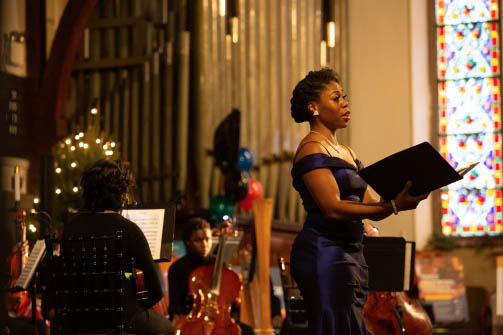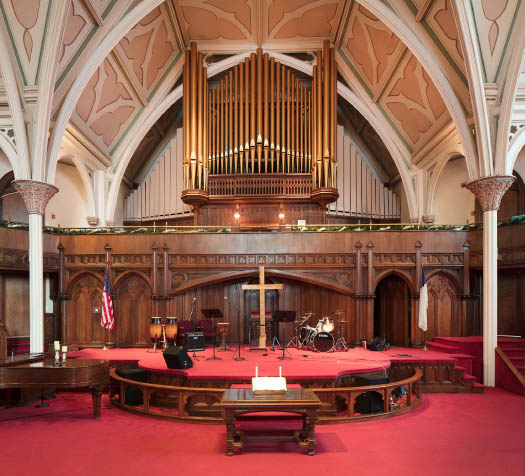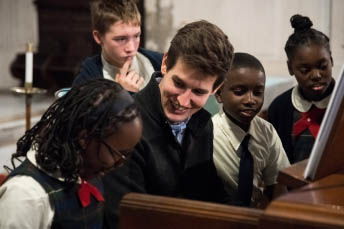
Chrystal E. Williams, mezzo-soprano, performs with the Play On Philly Orchestra at a community concert at St. Mary’s Episcopal Church in West Philadelphia.
Chrystal E. Williams, mezzo-soprano, performs with the Play On Philly Orchestra at a community concert at St. Mary’s Episcopal Church in West Philadelphia. Photo: Plate 3
Our eyes may be the first to apprehend the beauty of the sacred places we love so much, but it is our ears that appreciate the inspiring music that fully brings a sacred place to life. And it is the splendor of the pipe organ that inevitably comes to mind when we think of music in a sacred place.
However, just as historic sacred places across the nation are facing challenges and threats in this era, pipe organs are also facing disrepair—or even dismantling—due to a paucity of resources and funding. In spite of their grandeur and longstanding presence in sacred places, the larger public knows very little about the fate of these impressive instruments. Guided and supported by a wide coalition of allies, in 2018 Partners decided to shine a spotlight on Philadelphia’s magnificent pipe organs, by helping congregations care for them and find new ways to bring communities together to hear them play.
Congregations often reach out to Partners about their aging, sometimes long-silent pipe organs, looking for funding that could help them restore their beloved instruments. They frequently express their frustrations over how to care for their instruments or how they might find the right professionals to assess their needs and make repairs.

Facade pipes, interior of Highway Mission Tabernacle Church, Philadelphia. Photo: Joseph E.B. Elliott
Responding to these needs, in 2018 Partners launched Playing & Preserving: Saving and Activating Philadelphia’s Historic Pipe Organs In Advancement of Music and Community—the first major effort of its kind in the nation. Partners’ goal has been to survey the condition of 50 historic pipe organs, build the capacity of congregations to care for the pipe organs they cherish, and develop new audiences for pipe organs and sacred places by hosting concerts that bring together organists and other musicians.
Partnerships are a key theme for the Playing and Preserving project. To help engage school-aged children and their families, Partners gathered together an exciting team that included Play On Philly, which provides music education to city schoolchildren using the El Sistema method, and Astral Artists, a national organization which helps some of classical music’s rising stars build their careers. At the center of this partnership was St. Mary’s Episcopal Church in West Philadelphia, on the edge of the University of Pennsylvania campus, which worships in a Gothic Revival church with a rich legacy of liturgy, art, and social activism, at the center of which stands a historic 1937 Aeolian-Skinner (Opus 963) organ.
St. Mary’s served as the host for a series of three community-focused concerts organized by Astral Artists that included their national fellows performing alongside Play On Philly student ensembles. Many of the students who attend Play On Philly’s programs attend nearby St. Francis de Sales parish school, which helped connect the project with a more diverse group of families beyond the university campus.
The performances at St. Mary’s created a groundbreaking opportunity for students to experience an important historic sacred place, be exposed to the thrills and wonders of the pipe organ, and make music with professional musicians, with their families in attendance. To give children and their families an opportunity to learn more about the “King of Instruments” and what makes it so unique, displays and a video created by featured organist Greg Zelek of the Madison Symphony were available before concerts. These learning stations also included activities to help children discover the history and architecture of St. Mary’s. Each concert embraced a fun and festive approach that encouraged learning in an informal and approachable way.
Mezzo-soprano Chrystal E. Williams, who recently made her debut at the Metropolitan Opera, was the featured vocalist in the final concert of the series, which focused on “Love” as its theme. Like the other performers, she spoke to the audience, noting that “performing here is very different from the stage. This [sacred place] is welcoming and inclusive. People can be welcomed here and experience music in a way that is different from the concert hall, and thus provides access to people who might not otherwise feel welcomed.”
St. Mary’s is also one of ten churches that are receiving grants totaling $190,000 to help restore their organs. In St. Mary’s case, the $50,000 grant, which is being matched by the congregation’s fundraising efforts, will allow for a thorough restoration of much of the mechanical systems and pipework, long overdue. Adam Dieffenbach, the principal at Emery Brothers organ builders and restorers, which is conducting the restoration, described the Playing and Preserving technical assistance grants as “much needed.” He noted that congregations are finding few external resources to support their organ restoration projects.
Each of the congregations in the project were invited to participate in a full day of training at historic Tindley Temple United Methodist Church in Philadelphia. Partners customized its respected New Dollars/New Partners for Your Historic Sacred Place training for this program, teaming up with staff from Patrick J. Murphy & Associates organ-builders, who gave an introduction to maintenance, repair, and organ issues to nearly forty clergy and lay leaders from 11 congregations across the city. Partners provided guidance to each congregation on how to articulate the larger civic value of its building and historic pipe organ, laying the foundation for community-wide fundraising.
Partners also conducted the first ambitious survey of the condition and playability of historic pipe organs across Philadelphia. A partnership with the acclaimed Curtis Institute of Music helped Partners assemble a small team of organ students to survey nearly 50 historic pipe organs. Curtis students documented the condition of each pipe organ, and in many cases made short recordings to demonstrate the unique sounds of each instrument. Although the survey discovered that many instruments were no longer playable, a number of pipe organ gems were uncovered, such as the late 19th century organ made by George Jardine and Sons at the Free Church of St. John in the Kensington neighborhood. One of only a few by Jardine in the region, this graceful yet modest instrument maintains a warm timbre that sets it apart from many of the instruments by more well-known builders such as Skinner or Haskell.

Greg Zelek, Principal Organist of the Madison Symphony Orchestrak gives students for the Play On Philly wind ensemble a closer look at the console at St. Mary’s.
Photo: Daniel Kontz
The field surveys also include photographs by Joe Elliott, widely respected for his work for the Historic American Buildings Survey. He joined several students in visits to each of the sites to capture the building and instrument with high-quality photographs that will supplement the survey data and recordings.
Thanks to a new partnership with the Organ Historical Society, all of the survey work completed to date will be made available online as a resource for pipe organ enthusiasts, preservationists, and musicians. Partners hopes that this information—and this project’s work to encourage better stewardship and wider audiences—will lift up pipe organs as community assets. Partners’ goal has been to bring attention to the need for pipe organ preservation, and inspire congregations to build a wider network of allies to support their preservation for new generations of listeners and friends.
The project was made possible through the generosity of several funders, including The Pew Center for Arts & Heritage, the Wyncote Foundation, and the 25th Century Foundation.
